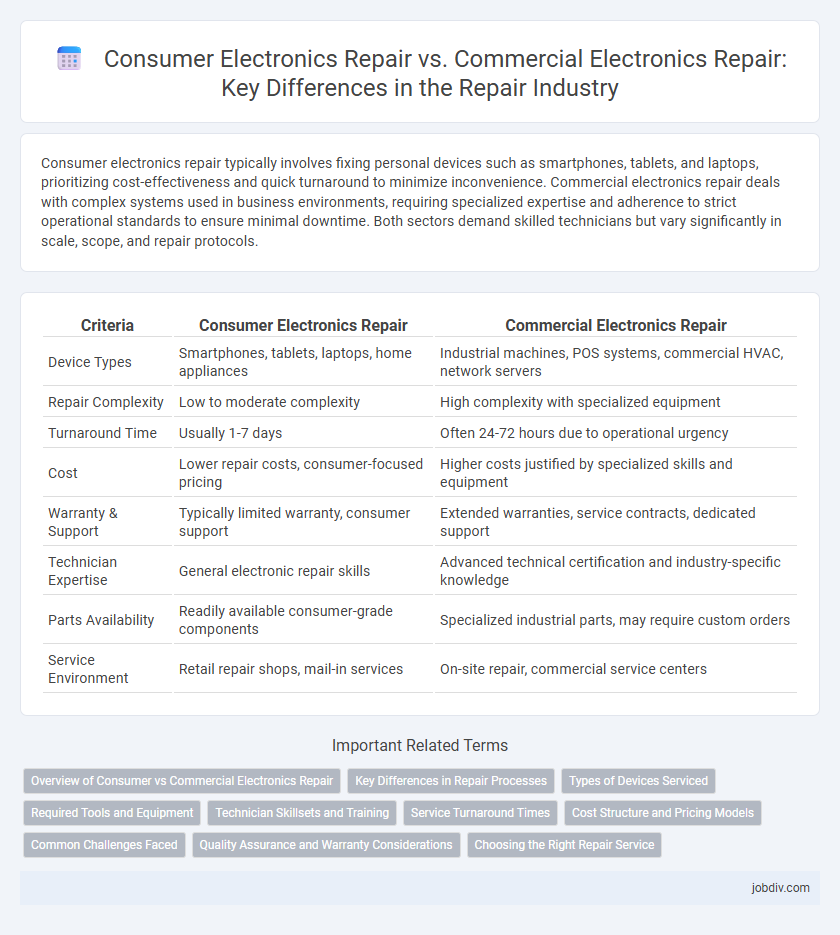Consumer electronics repair typically involves fixing personal devices such as smartphones, tablets, and laptops, prioritizing cost-effectiveness and quick turnaround to minimize inconvenience. Commercial electronics repair deals with complex systems used in business environments, requiring specialized expertise and adherence to strict operational standards to ensure minimal downtime. Both sectors demand skilled technicians but vary significantly in scale, scope, and repair protocols.
Table of Comparison
| Criteria | Consumer Electronics Repair | Commercial Electronics Repair |
|---|---|---|
| Device Types | Smartphones, tablets, laptops, home appliances | Industrial machines, POS systems, commercial HVAC, network servers |
| Repair Complexity | Low to moderate complexity | High complexity with specialized equipment |
| Turnaround Time | Usually 1-7 days | Often 24-72 hours due to operational urgency |
| Cost | Lower repair costs, consumer-focused pricing | Higher costs justified by specialized skills and equipment |
| Warranty & Support | Typically limited warranty, consumer support | Extended warranties, service contracts, dedicated support |
| Technician Expertise | General electronic repair skills | Advanced technical certification and industry-specific knowledge |
| Parts Availability | Readily available consumer-grade components | Specialized industrial parts, may require custom orders |
| Service Environment | Retail repair shops, mail-in services | On-site repair, commercial service centers |
Overview of Consumer vs Commercial Electronics Repair
Consumer electronics repair typically involves fixing devices like smartphones, laptops, and home appliances for individual users, emphasizing cost-effective solutions and quick turnaround times. Commercial electronics repair addresses complex equipment such as industrial machinery, professional audio-visual systems, and office hardware, requiring specialized technical expertise and compliance with industry standards. Distinct differences include scale, technical complexity, and service agreements, with commercial repairs often involving longer service contracts and higher precision diagnostics.
Key Differences in Repair Processes
Consumer electronics repair typically involves dealing with individual devices such as smartphones, laptops, and tablets, requiring diagnosis and resolution of common issues like screen damage, battery replacement, and software troubleshooting. Commercial electronics repair focuses on complex systems like industrial machinery, networking equipment, and point-of-sale terminals, necessitating specialized knowledge, adherence to strict protocols, and often collaboration with the manufacturer for parts and warranties. Turnaround times and repair scalability significantly differ, with commercial repairs demanding faster, bulk processing to minimize business downtime while consumer repairs prioritize cost-effectiveness and convenience.
Types of Devices Serviced
Consumer electronics repair primarily involves devices such as smartphones, laptops, tablets, and home entertainment systems, focusing on individual user needs and commonly includes battery replacements, screen repairs, and software troubleshooting. Commercial electronics repair targets more complex equipment like industrial machines, server systems, networking hardware, and point-of-sale terminals, requiring specialized knowledge in diagnostics and component-level repairs. The scope of devices serviced in commercial repair demands adherence to industry standards and downtime minimization, contrasting with the often quicker and simpler consumer electronics fixes.
Required Tools and Equipment
Consumer electronics repair typically requires handheld tools such as precision screwdrivers, multimeters, soldering irons, and anti-static mats designed for small-scale devices like smartphones and laptops. Commercial electronics repair demands industrial-grade equipment, including oscilloscopes, specialized diagnostic software, rework stations, and large-scale testing rigs to handle complex machinery and high-volume repairs. Proper calibration tools and safety equipment are essential in both areas but are more advanced and robust in commercial settings to ensure compliance with industry standards.
Technician Skillsets and Training
Consumer electronics repair technicians typically specialize in diagnosing and fixing smartphones, tablets, and laptops, requiring proficiency in soldering, software troubleshooting, and component-level repairs. Commercial electronics repair technicians possess advanced skills in maintaining complex systems such as industrial machinery, networking equipment, and large-scale audio-visual setups, often necessitating certifications in specialized diagnostics and system integration. Training for commercial repair professionals includes extensive coursework in high-voltage safety and system architecture, whereas consumer electronics repair training emphasizes rapid device turnaround and user interface repair techniques.
Service Turnaround Times
Consumer electronics repair typically involves shorter turnaround times, averaging 3 to 7 business days due to standardized parts and less complex diagnostics. Commercial electronics repair often requires extended service periods, ranging from 7 to 14 days or more, driven by intricate systems and customized components. Fast repair turnaround is crucial in commercial settings to minimize operational downtime and ensure business continuity.
Cost Structure and Pricing Models
Consumer electronics repair typically involves lower cost structures with standardized pricing models due to the high volume and similarity of devices like smartphones and laptops. Commercial electronics repair demands higher costs driven by specialized equipment, skilled technicians, and custom pricing tailored to complex systems and bulk service contracts. Pricing models in consumer repair often rely on fixed fees or flat rates, while commercial repair frequently implements time-and-materials or negotiated service level agreements (SLAs).
Common Challenges Faced
Consumer electronics repair often involves diagnosing issues with diverse devices like smartphones, laptops, and tablets, where compatibility of replacement parts and rapid technology updates create ongoing challenges. Commercial electronics repair requires handling complex systems such as industrial machinery, networking equipment, and point-of-sale terminals, demanding specialized knowledge and minimal downtime to avoid operational losses. Both sectors face difficulties in sourcing authentic components, maintaining data security, and providing cost-effective solutions while meeting varied client expectations.
Quality Assurance and Warranty Considerations
Consumer electronics repair typically involves standardized warranty coverage, focusing on individual device quality assurance with manufacturer guidelines to ensure optimal performance post-repair. Commercial electronics repair demands rigorous quality assurance processes tailored to high-volume, mission-critical equipment, often requiring extended warranties and service level agreements (SLAs) to minimize operational downtime. Warranty considerations in commercial repair include customized terms reflecting usage intensity and environmental factors, ensuring reliability for business continuity.
Choosing the Right Repair Service
Consumer electronics repair typically involves devices like smartphones, laptops, and home appliances, where affordability and quick turnaround are crucial. Commercial electronics repair caters to specialized equipment such as industrial machinery, point-of-sale systems, and networking hardware, requiring technicians with advanced expertise and certification. Choosing the right repair service depends on the complexity of the device, warranty coverage, and the technician's experience with specific commercial or consumer electronics brands.
Consumer Electronics Repair vs Commercial Electronics Repair Infographic

 jobdiv.com
jobdiv.com